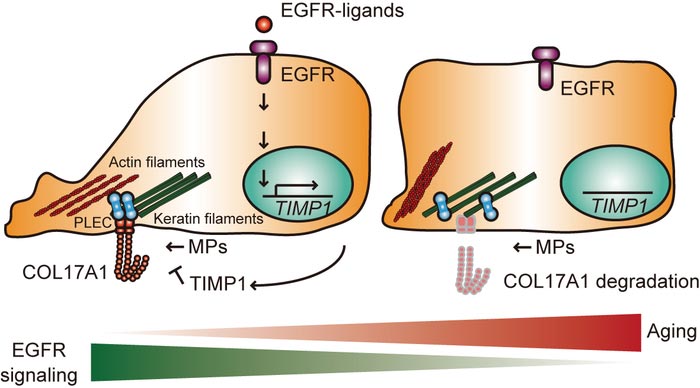Skin stem cells get moving for enhanced skin regeneration

EGFR signaling stabilizes COL17A1 through TIMP1 induction, which is required for cell motility coordinated by actin and keratin filament networks. The age-associated decline of EGFR signaling results in impaired reepithelialization and skin regeneration. MPs, metalloproteinases.
Credit: Department of Stem Cell Biology, TMDU
Researchers from Tokyo Medical and Dental University (TMDU) have found that the movement of skin stem cells can help your skin regenerate.
Although sometimes hard to accept, with aging, many things in our bodies change. One of these is the ability of the skin to regenerate. Old skin is just not as good as young skin at healing wounds. However, the molecular and cellular mechanisms underlying this are largely unknown. Now, researchers from Japan have identified a mechanism to explain why this happens and potentially how it can be fixed.
In a study published this month in the Journal of Cell Biology, researchers from Tokyo Medical and Dental University (TMDU) have revealed that the ability of skin stem cells to repair skin after an injury may be linked with their ability to move towards the injury.
Skin stem cells, also called keratinocyte stem cells, are responsible for skin regeneration and wound closure through a process called re-epithelialization. “Live-imaging and computer simulation experiments showed that human skin stem cells motility is coupled with their proliferative and regenerative capacity and old stem skin cells have a significantly reduced motility”, explains Daisuke Nanba, lead author of the study.
To understand the mechanisms behind this reduced motility in old stem cells, the researchers compared the wound healing and proliferative ability of skin stem cells derived from young mice (12 weeks old) and aged mice (19-25 months old). The experiments showed that a specific molecule, called EGFR (Epidermal Growth Factor Receptor), drives skin stem cell motility and that EGFR signalling is reduced in old stem cells. EGFR acts by preventing the degradation of a specific type of collagen, COL17A1, which is necessary to hold the layers of the skin together.
Interestingly, COL17A1 coordinates the movement of skin stem cells towards the injury by regulating actin and keratin filament networks in the cells. The researchers found that with age, a decrease in EGFR signalling occurs, leading to lower levels of COL17A1 and skin stem cells with reduced mobility that are less able to re-epithelialize the skin.
With advanced age, a reduced skin wound healing ability is associated with the development of so-called chronic nonhealing disorders, such as diabetic ulcers and pressure sores. “Although further investigations are still required, stabilizing COL17A1 by regulating its proteolysis is a promising therapeutic approach for improving the decline in skin regeneration observed with age that often leads to serious issues such as ulcers”, says Emi Nishimura, senior author on the study. This research sheds further light on the mechanisms underlying wound healing and may lead to the development of new therapeutic treatments to improve skin regenerative capacity.
The article “EGFR-mediated epidermal stem cell motility drives skin regeneration through COL17A1 proteolysis” was published in the Journal of Cell Biology at doi.org/10.1083/jcb.202012073.
Journal: Journal of Cell Biology
DOI: 10.1083/jcb.202012073
Article Title: EGFR-mediated epidermal stem cell motility drives skin regeneration through COL17A1 proteolysis
All latest news from the category: Life Sciences and Chemistry
Articles and reports from the Life Sciences and chemistry area deal with applied and basic research into modern biology, chemistry and human medicine.
Valuable information can be found on a range of life sciences fields including bacteriology, biochemistry, bionics, bioinformatics, biophysics, biotechnology, genetics, geobotany, human biology, marine biology, microbiology, molecular biology, cellular biology, zoology, bioinorganic chemistry, microchemistry and environmental chemistry.
Newest articles

A universal framework for spatial biology
SpatialData is a freely accessible tool to unify and integrate data from different omics technologies accounting for spatial information, which can provide holistic insights into health and disease. Biological processes…

How complex biological processes arise
A $20 million grant from the U.S. National Science Foundation (NSF) will support the establishment and operation of the National Synthesis Center for Emergence in the Molecular and Cellular Sciences (NCEMS) at…

Airborne single-photon lidar system achieves high-resolution 3D imaging
Compact, low-power system opens doors for photon-efficient drone and satellite-based environmental monitoring and mapping. Researchers have developed a compact and lightweight single-photon airborne lidar system that can acquire high-resolution 3D…





















